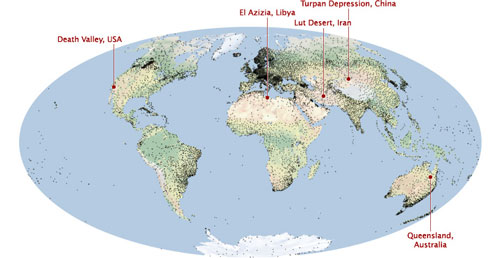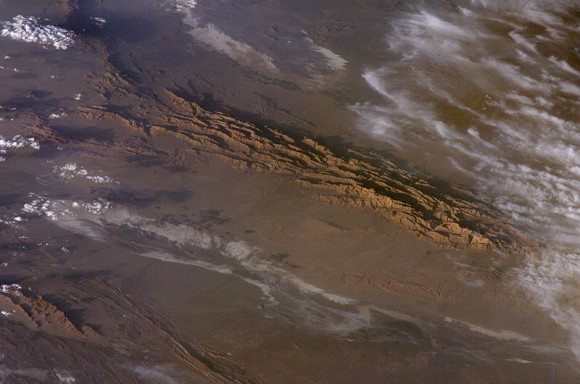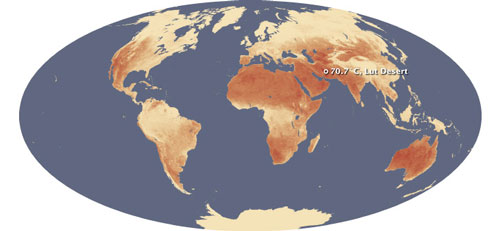The Lut Desert in Iran, the Turpan Basin in China and the badlands in Queensland, Australia are among the hottest places on Earth, according to scientists from the University of Montana who analyzed satellite records of land surface temperatures dating from 2003 to 2009. The results of their research were published in the July 2011 issue of the Bulletin of the American Meteorological Society.
But the question of “where is the hottest place on Earth” is a contentious issue. In 1913, a weather station in Death Valley National Park, California measured a record high air temperature of 56.7 oC (134.1 oF). In 1922, the record for the hottest place on Earth was surpassed by El Azizia, Libya where an air temperature of 57.8 oC (136.0 oF) was measured, but that record is under dispute due to a possible thermometer malfunction. Regardless, these early air temperature records have never been exceeded.
The World Meteorological Organization has approximately 11,119 weather stations that collect information on surface air temperatures. Unfortunately, many of these weather stations are located outside of the remote areas that are likely to be the hottest places on Earth.

David Mildrexler, lead author of the new study and a research scientist at the University of Montana, commented on the lack of surface air temperature data in an April 5, 2012 interview with NASA’s Earth Observatory. He said:
The Earth’s hot deserts – such as the Sahara, the Gobi, the Sonoran, and the Lut – are climatically harsh and so remote that access for routine measurements and maintenance of a weather station is impractical. The majority of Earth’s hottest spots are simply not being directly measured by ground-based instruments.
Mildrexler and his colleagues Maosheng Zhao and Steven Running, who are also affiliated with the University of Montana, decided to try a different approach to finding the hottest place on Earth – they looked at satellite data.
The scientists chose to analyze data on land surface temperatures that were collected by MODIS (Moderate Resolution Imaging Spectroradiometer) aboard NASA’s Aqua satellite. The Aqua satellite makes an afternoon overpass of the Earth every day and collects data on the amount of infrared energy emitted by the land surface. While land surface temperatures are different from, and hotter than, surface air temperatures – similar to the way that sand on a beach feels much hotter than the overlying air – satellite data on land surface temperatures provide more complete coverage of conditions across the Earth than do air temperature data from weather stations.

Results from the new study indicate that the Lut Desert in Iran is likely one of the hottest places on Earth. In 2005, the land surface temperature in the Lut Desert reached a sweltering 70.7 oC (159.3 oF), the highest temperature observed during the entire time period that was analyzed. Temperatures in the Lut Desert were also the highest observed anywhere on Earth during 2004, 2006, 2007 and 2009 with temperatures during these years ranging from 68.0 oC (154.4 oF) to 69.0 oC (156.2 oF).

Interestingly, the Lut Desert was not the hottest place on Earth every year. In 2003, the Aqua satellite measured a record high temperature of 69.3 oC (156.7 oF) in the badlands of Queensland, Australia. During 2008, the record for the hottest place on Earth went to the Turpan Basin in China where temperatures reached 66.8 oC (152.2 oF). The Turpan Basin is covered by dark red sandstone that heats up to extreme temperatures in the afternoon sun.
Land surface temperatures are influenced by a variety of factors including changes in solar radiation, changes in land cover and changes in atmospheric conditions. As more years of data accumulate, the scientists are hoping that land surface temperatures could become a new type of integrative global change measurement.
Bottom line: The Lut Desert in Iran, the Turpan Basin in China and the badlands in Queensland, Australia are among the hottest places on Earth, according to scientists from the University of Montana who analyzed satellite records of land surface temperatures dating from 2003 to 2009. The results of their research were published in the July 2011 issue of the Bulletin of the American Meteorological Society.
In March 2012, 15,000 warm temperature records broken in US











